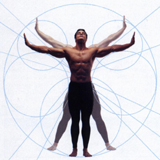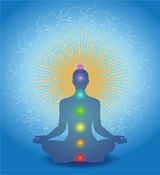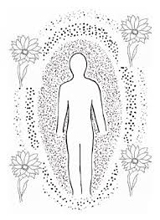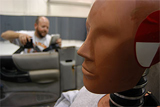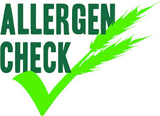Alternative healing
Creating a healing atmosphere within centres and for a spiritual community: an investigative study — I
Abstract
This pilot investigation was designed to create a healing atmosphere, referred to as Integral Bio-Energetic Field (IBEF) at four centres and at a spiritual community. Its aim was to develop and implement the healing atmosphere and to evaluate its effectiveness. The investigator considers himself as guided by the principles of Sri Aurobindo’s and the Mother's Integral Yoga, seeking the divine Grace and to be in harmony with emergent global healing.
The present article highlights two major IBEF components: applied kinesiology (AK) and a bio-energetic healing system known as Nambudripad Allergy Elimination Technique (NAET). AK is a standard technique of muscle-testing to reveal bio-energetic imbalance of organs or body systems. NAET is a system to identify and eliminate an allergy or reaction to a bio-incompatible substance. The two components are reviewed — focusing on testing others or self for energy-balance, allergies, and related healings. The testing can be repeated before and after a person's exposure to an IBEF centre in order to demonstrate and verify its multiple healing functions.
Overview
This pilot-study examines the ways in which a healing atmosphere referred to as Integral Bio-Energetic Field (IBEF) was developed, generated, induced for sustained healing and evaluated for its effectiveness. IBEF is designed to integrate, in conjunction with Integral Yoga healing, two bio-energetic approaches: applied kinesiology and an allergy elimination system known as NAET. For the investigation, IBEF was generated at four centres located in northern California – a fitness centre, an Indian restaurant, a cafe, and an Integral Yoga ashram. Shortly thereafter, IBEF was induced on a larger scale for the Integral Yoga community of Auroville located in south India. Following the IBEF induction, its healing atmosphere was found to be present, activated and effective at each of the four centres and at the Auroville community.
Summarised below are two major IBEF components, namely, applied kinesiology and the bio-energetic system, NAET. Additional phases of the pilot study, including IBEF-vial development, IBEF induction into the centres, and the pilot-evaluation will be presented in subsequent NAMAH articles.
Applied kinesiology (AK)
AK is a tool used in alternative medicine to observe muscular indicators of an illness, disorder or imbalance and to choose the best treatment option based on testing specific muscles for strength or weakness. AK is used by chiropractors, as well as by naturopathic physicians, physicians, nurses, physical therapists, and veterinarians. It may be noted that AK’s validity has been questioned by The American College of Allergy, Asthma and Immunology, as well as the American Cancer Society. The latter stated that “scientific evidence does not support the claim that applied kinesiology can diagnose or treat cancer or other illness(1).” For the present study, however, AK is employed as an exploratory tool to obtain indicator-clues of muscular and body-component imbalances pertaining to wellness and healing.
AK-testing can be viewed as a way of assessing the body’s bio-energetic health status. ‘Bio-energetic’ refers to the energy body, comprised of magnetic-electrical energy channels as defined in Chinese medicine and parallel concepts of alternative medicine. In this perspective, the energy body is viewed as linked to the physical body — one influencing the other, in terms of wellness and healing dynamics. AK testing is conveyed to the energy body and transmitted to the physical body. On the other hand, a pain symptom of the physical body would be sent to the energy body, to be detected by AK-muscular testing.
AK — QRT
An AK technique known as Question-Response-Testing (QRT) provides a ‘Yes’ or ‘No’ answer on degree of muscular strength or weakness to questions relating to wellness and healing issues. It should be emphasised that AK-testing is limited to health/healing – not applicable to other subjects (e.g. “Can I make money on this investment?”).
How can the AK-testing/QRT be applied? A frequently used method involves finger-testing, as follows. Place the frontal pad of the middle finger (either hand) on the index finger’s nail, then press down. A slightly difficult press-down indicates a ‘Yes’ answer while an easier press-down is a ‘No’ answer (2).
An alternative AK testing technique (which I have developed) can be done in this way. Place your arms behind the back and clasp both hands together so that they touch the spine. Now try to lift up the clasped hands and arm to some extent. A slightly difficult lift-up, only 1-2 inches, indicates strength or a ‘Yes’ answer; an easier, longer lift-up, perhaps 2-4 inches, reveals a ‘No’ answer. The technique needs to be practised quite a few times to feel confident and assure its accuracy
While learning to do QRT, you can practise with a ‘name test’: say your name (“My name is...”), then QRT to receive a ‘Yes’ answer; next, say an incorrect name (“My name is...”) to receive a ‘No’ answer.
QRT can be used for such questions as: “Do I have an allergic reaction to a given substance?” if ‘Yes’, “what specific substance am I allergic to, is it...?” (e.g. sugar, salt, eggs) After the NAET treatment, ask “Has the allergy been cleared?” As will be explained in a later article, QRT can also be an important technique on a collective level, for addressing “Is IBEF present and functioning in this centre (3)?”
Standard muscle-testing
There are various ways of muscle-testing someone else. A standard method involves the practitioner gently pressing the patient’s raised arm, wrist and thumb pointing downward, and testing for relative strength or weakness of the arm-muscle. It functions as an indicator muscle or predetermined muscle called PDM . If the raised arm is weak and goes down under pressure, without the patient holding an allergen, he/she is not balanced. The testing can also be employed to detect and identify an allergic substance while the patient holds the suspected substance, as detailed below (‘NAET basic method’ sub-heading) (4).
AK-balancing and hindrances
Does one need to be concerned about energy imbalance, and obstacles that may distort or interfere with AK-testing? Yes, definitely: there are at least three requirements to prevent AK bias. First, for any self-testing or testing of another person he/she needs to be energetically balanced with respect to:
i. cakras
ii. Chinese meridian energy channels and
iii. making sure the testing is not affected by a negative energy force, known as an entity.
Cakra balance
One obstacle to AK-balancing is an imbalance of one or more of the cakras. There are seven cakras along the body’s frontal midline, from the lower trunk area to slightly above the head. The first cakra (root/’life force’) is located near the bottom of the pubic bone; second cakra (womb/’creativity’) below the navel; third cakra (solar plexus/ ‘assertiveness’) above the navel; fourth cakra (heart/ ‘love and compassion’) at midpoint of the line connecting the nipples of a male child; fifth cakra (throat/’expressiveness’) at throat area; sixth cakra ((pituitary/’third eye’) at the forehead midpoint above the eyebrows and seventh cakra (pineal/’crown’) slightly above the head. To test for cakra balance for any of them, a simple procedure can be used:
Begin with QRT: “Are all my cakras balanced?” If ‘Yes’, they are balanced; if the answer is ‘No’, test each cakra (e.g., “Is my first cakra balanced?”) to identify the imbalanced cakra. To balance the cakra, apply these steps:
1. Place either hand, open, palm down, 4 inches above the cakra; rotate the hand within a 3-inch circle counter-clockwise (as if you have placed a clock on the cakra); make slow circles about the width of the body or a bit less. Circle each cakra at least 15 times.
2. Next, do the same procedure but circle 10 times clockwise. Thereafter, QRT again, asking “Are my cakras now balanced?” If the answer is ‘Yes’, the balancing is completed.
If ‘No’, repeat the procedure for each cakra.
3. The same procedure would be applied for each of the seven cakras, with one exception. For a male person, the order of circling for the seventh cakra (slightly above the head) is reversed — circle first clockwise, then counter-clockwise (5).
Meridian balance
The second possible obstacle to AK-testing stems from imbalance within the meridian energy channel(s). The required balance testing and re-balancing will be considered below (‘NAET: basic method’ and ‘NAET re-balancing’ sub-headings).
For an alternative acupressure balancing method, the ten points shown in Appendix 1 can be massaged, without holding an allergic substance. Each point is massaged gently with finger-pads, for one minute, in a circular motion, clockwise. Start with pt-1, continue with pt-2, pt-3, pt-4, pt-5, pt-6, pt-7, pt-8, pt-9, pt-10, and finish with a repeated massage on point 1. Massaging these points will enhance overall energy and increase nerve energy circulation in the meridians. It is recommended that the points be massaged after each NAET treatment to make sure that the treatment will endure (6).
Adverse energy
The third potential obstacle has to do with an adverse energy force, referred to as an entity. It can enter a person’s energy field and lead to disruptions in the physical, vtal, and mental bodies as defined in the Integral Yoga, affecting well-being and healing (7).
Based on my AK experience, the entity can be identified and dispelled in the following way:
First, QRT “Do I have negative energy in the form of an entity?” If ‘Yes’, apply either of two methods:
a) State the affirmation, “With divine Guidance, may the existing entity be dispelled and may I hereby be replenished with positive energy”; or
b) Using the index and middle fingers of the right hand, tap 10 times one inch above the navel; then, tap 10 times between the eyebrows.
Next, QRT again “Do I still have an entity in my being?” If the answer is ‘No’, the entity has been cleared; if ‘Yes’, a) or b) needs to be repeated, until a ‘No’ answer is received.
Systems analysis
A comprehensive approach of AK testing for wellness and healing can be done based on an analysis of body systems and their components. The method is done in three stages, as follows:
a) Identify the bio-energetic imbalance(s) which might be affecting one or more systems, organs, and body functions;
b) Review treatment options: standard medical treatment and alternative modalities.
c) Monitor treatment progress.
The AK-QRT measures are given as per-centage estimates in order to evaluate the functions of major systems and their components. Separate estimates can be obtained at two levels: the physical body and the energy body. Before doing the QRT, state either “physical body” or “energy body”.
The systems analysis requires several sequential steps of QRT:
1. What is the person’s overall percentage of wellness? (100% = Normal Wellness).
2. Does any bodily system function below 100%? If ‘Yes’, how many and which systems — (digestive, nervous, muscular, circulatory, blood, sexual, hormonal and other/specify). For each system, what is the percentage?
3. Do any of the major organs function below 100%? If so, how many and which ones? For each organ, specify the percentage below 100%.
4. For the system and component organ functioning below 100%, identify probable causal factor(s) with QRTs. There may be a causal chain, one factor linked to or leading to another. The factors can be classified into 4 major categories:
a) Pathogens (bacteria, viruses, yeast/mould [fungus] and parasites);
b) Allergies (foods, chemicals, medications, emotional or interpersonal);
c) Toxic exposure (pesticides, petroleum/gasoline, heavy metals such as mercury and lead, etc.); and
d) Chronic disorder (e.g. arthritis, cardiac, stomach ulcer, cancer).
One can QRT for the causal factor(s) with the process of elimination, by QRT-testing 1) the four categories, 2) their components, and 3) the individual substances of a given component.
Three of the category-factors (pathogens, allergies, toxic exposure) can often be treated and eliminated with NAET or related bio-energetic methods as well as by medical intervention. The fourth category, however, chronic disorder, is often complex, multi-layered and less open to treatment. Yet when addressed with NAET, there may be degrees of improvement or stages of healing. A systems analysis with respect to the first three causal categories a) to c) would help to assess and address such improvement.
For people taking medication(s), it is advisable to periodically check for any allergic reactions. This can be done by holding the medication in one hand and AK-testing — the muscle-testing indicator would show either relative strength (non-allergic) or weakness (allergic reaction). In the latter case, the patient can eliminate the allergy by:
a) receiving NAET session(s) from a certified NAET practitioner; or
b) attending a centre for which the IBEF healing atmosphere had been induced.
5. For evidence of a chronic disorder, one or more treatment options can be selected. While medical intervention often deserves priority, alternative modes such as NAET, acupuncture and massage/reflexology or a combination of modes can be viewed as adjuncts. For the best choice, QRT the major options, as well as ask for divine Guidance.
6. Periodic monitoring of 1) to 4) in order to evaluate treatments. To this end, AK-test percentages for overall wellness, system and organ functions, major causal factors (pathogens, allergies and toxicity), and chronic disorder improvement to assess health status. When the percentages are too low or fail to show improvement over time, the treatment strategy may need to be changed and re-evaluated.
NAET
Initiated in 1993, the Nambudripad Allergy Elimination Technique (NAET) is a method for detecting and eliminating allergies. Its scope extends beyond the medical definition of allergies to include any bio-incompatible substance or condition resulting in energetic imbalances, such as pathogens, toxic elements and allergic reaction between two persons.
Numerous allergy research studies have been conducted and published by the Nambudripad Allergy Research Foundation (NARF) in its Journal of NAET, Energetics and Complementary Medicine (8). The studies cover a wide range of peer-reviewed, controlled experiments that have demonstrated NAET’s effectiveness. Also several books have been published explaining NAET in non-technical language, its benefits, self-testing and other practical applications (9), (10).
The NAET concepts and steps summarised below represent a simplified version, in order to familiarise the reader with its basic procedure and facilitate self-help. Standard NAET treatment by a certified practitioner generally requires several sessions to identify and clear underlying allergies and any related disorders.
NAET: basic method
For initial diagnosis by the NAET practitioner, the patient holds the suspected allergic substance and is muscle-tested. An allergic reaction would cause an imbalance affecting the nervous system and the brain which, in turn, leads to a degree of weakness in the muscular system. This can be detected by muscle-testing. The patient holds out his/her left arm (thumb pointing downward) and resists the practitioner’s pressing down on the wrist. A significant degree of muscle weakness indicates there is an allergic reaction, whereas normal muscle strength indicates no allergic reaction (11).
The NAET treatment involves a series of steps based partly on Chinese medicine and chiropractics. While the patient holds a vial for an allergic substance, the practitioner applies an acupressure testing technique to identify the specific energy channels (meridians) and organs revealing imbalance. Accordingly, a re-balancing procedure is applied involving multiple configurations of acupressure points along the spine. Thereafter, a series of meridian points are balanced for the total body system, with acupuncture or a device designed for this purpose. The patient is advised to avoid ingesting or being near the allergic substance for 25 hours.
Among the NAET techniques for checking a patient’s balance, two can be briefly described:
1. To determine whether or not the patient is balanced, a polarity test can be used. To do so, the practitioner muscle-tests the patient’s arm (as described above) twice:
first, while holding his index and middle fingers over the patient’s brow;
second, while holding the reversed or back of the two fingers over the patient’s brow.
For the patient to be balanced, the first test would indicate strength and the second weakness during the arm-muscle testing. If the patient shows imbalance, NAET balancing is necessary, as detailed below.
2. An alternative way to check balance can be done as follows. First, arm-muscle (PDM) test the patient who is not holding a substance for which he/she had been shown to be allergic. A strong PDM indicates that the patient is balanced. Next, repeat the testing while the patient holds a substance for which he/she has an allergic reaction — a weak PDM would confirm that the patient is balanced. If the PDM shows weakness without the presence of the allergic substance, the patient would appear to be imbalanced.
NAET re-balancing
The NAET balancing technique generally used draws upon Chinese meridian principles.
Step 1 — the practitioner or the tester places:
a) his/her right-hand on the patient’s Point 1, called ‘Sea of Energy’, with the tips of three fingers (index, middle and ring) 1 inch below the navel; and
b) the left hand’s three fingers on the patient’s Point 2, named ‘Dominating Energy’, located in the centre of the chest along the body’s midline.
Point 1 is an energy reservoir; to be gently massaged clockwise with three fingertips of the right hand for a few seconds while holding Point 2 with three fingertips of the left hand. Thereby, the Point 1 ‘Sea of Energy’ will release energy into the Point 2 ‘Dominating Energy’.
Step 2 — hold Point 1 and gently massage Point 2 clockwise for a few seconds. It is the point that disperses, circulates energy or Chi, to where it is needed, the different meridians, organs, tissues and cells while pushing energy blockages out of the body and balancing it throughout. The results can be felt in the strength of the indicator muscle. Upon completing Steps 1 and 2, re-check the patient’s PDM balance. Most likely, it will be strong. If still weak or imbalanced, the above two steps need to be repeated until the indicator muscle shows strength.
There are occasions when the patient, usually a man, is imbalanced because of excessive energy in the meridian energy channels. In this case, the above procedure would be reversed to allow a reset; that is, you would massage both points counter-clockwise as explained above, first, Point 1, then Point 2. Then, retest to see if the patient is balanced. If not, the procedure may need to be done again, but massage the two points for a shorter period (11).
Surrogate testing
It is possible, with the help of a third person as surrogate, for a recipient/patient who is incapacitated, to be NAET tested and treated. The recipient might be disabled, unconscious, an infant, a hyperactive child, an autistic child, an extremely strong or a very weak person. A pet can also be tested and given NAET.
The procedure is done without causing any interference or effect on the surrogate person, while he/she is tested and treated on behalf of the recipient/patient (incapable of being tested). The testing and treatment will affect only the recipient, while the latter maintains continuous skin-to-skin contact with the surrogate.
A pet can be NAET tested/ treated while the surrogate touches the animal’s paw or it is held on the surrogate’s chest. Pets might be allergic to their daily food, drinks, tap water, the collar, rug or mat where it sleeps, vitamins, drugs, vaccination, insects, fleas, tics, fungus, etc.
Moreover, the owner might be allergic to the pet or the pet toward the owner (12). To test, one can QRT, “Am I allergic to my pet (dog, cat, etc.)?” or, “Is my pet allergic to me?” If ‘Yes’, an appropriate NAET needs to be given by a NAET practitioner.
Person-to-person allergy
At times, two persons can be allergic to one another — for example, a husband and wife, a child to a parent, or to a friend or immediate associate. This may be manifested by feuding over trivial matters, feelings of disharmony, illness, or symptoms similar to those experienced with an allergic reaction to foods, chemicals, and other substances. The suspected person-to-person allergy would need to be identified and treated by a qualified practitioner.
For the allergy testing, the person/subject lies down and touches a second person toward whom an allergic reaction is suspected. Next, the practitioner or a third individual acting as tester, PDM-muscle tests the arm of the subject. If the indicator muscle goes weak, the subject is allergic to the second person. If the indicator muscle remains strong, the subject is not allergic to the person. When there is an allergic reaction, both persons would need NAET treatment by a practitioner (13).
NAET basic allergens and treatment plan
NAET practitioners have found that there are 15 basic allergens which, when detected, need priority to be cleared as they are often underlying or associated with other allergies. PDM testing for the 15 allergens and eliminating them tends to dispel or prevent other allergens. The list consists of:
1. BBF (autonomic nervous system balance)
2. Egg mix (proteins)
3. Calcium mix
4. Vitamin C mix
5. B complex
6. Sugar mix
7. Iron mix
8. Vitamin A mix
9. Minerals, water
10. Salt mix
11. Grains
12. Yeast mix, yoghurt and whey
13. Stomach acid
14. Digestive enzymes or base
15. Hormones
The practitioner would PDM-test for the presence of any of the 15 basic allergens. One could also QRT for each of the 15 allergens, e.g., “Do I have an allergic reaction to BBF?” (‘Yes’ or ‘No’; thereafter, confirm with PDM testing.
After testing for and treating the basic 15 allergens, the practitioner would evaluate and set additional possible priorities for a treatment plan. It would include any immediate health problem, taking into account 40 additional major allergen groups, listed below. The plan may focus on disorders such as PMS, learning disability, ADHD, dyslexia, autism, asthma, and migraine headaches, or other specific health problems.
40 additional allergens
For simplification, the 40 additional groups of allergens can be divided into nine categories:
1. Foods, food-related: fish and shell-fish, nightshade vegetables/vegetable mix, vegetable fat and animal fat, nut mix, coffee, gelatine, spice mix, dried bean mix, turkey/serotonin, gum mix amino acids, artificial sweetener, starch mix, alcohol, and food-colouring/food-additives
2. Household: chemicals (soap, detergents, etc.), whiten-all
3. Cosmetics: perfume mix/flowers
4. Other chemicals: fluoride, formaldehyde, smoking/nicotine, heavy metals (mercury, lead, etc.), pesticides, crude oil, synthetic materials, latex/plastics
5. Human body: organs or tissues (especially parts of the body involved with the disease process — lung, liver, kidneys, hypothal-amus, etc.) and neurotransmitters
6. Drugs: immunisations/vaccinations/drugs
7. Animal: dogs, cats, animal epithelial/dander
8. Pathogen: bacteria mix, virus mix, parasites
9. Nature: pollen, grasses/weeds, dust
To identify the substance to which there is an allergic reaction, a 4-step process of elimination for the nine categories is listed below:
1. Begin by asking “Am I allergic to any item within the nine categories?” If ‘Yes’:
2. QRT each category (e.g., “Is it Category 6 — drugs?”) until a ‘Yes’ for a certain category.
3. Within that category, QRT each item to identify the individual allergy (e.g., “Is it dust?”, if ‘Yes’):
4. Repeat step 1; if it indicates ‘Yes’, do steps 2 to 3 again, to disclose the additional allergy.
IBEF Verification
Familiarity with the above procedures — testing for balance of cakras and meridians, re-balancing, estimating extent of wellness, identifying allergies and causal factors — can serve to verify the activation of IBEF induced at a centre. For example, an initial cakra imbalance will presumably be corrected by IBEF. To confirm this assumption, one would:
1. Test/demonstrate the cakra imbalance before initial exposure to the IBEF centre;
2. Re-test the cakra for balance soon after attending the centre.
The resulting cakra re-balancing would verify that IBEF is functioning as expected, covering multiple dimensions.
Conclusion
Numerous studies have demonstrated that NAET can effectively treat a wide range of physical, nutritional, environmental and emotional health issues. Thus NAET was selected as a core element for generating the IBEF healing atmosphere.
In its full scope, NAET requires a variety of refined practitioner techniques to ensure that the patient is ready for NAET, responds well to sessions and that priority health problems are addressed and resolved. For comprehensive NAET treatment, the doctor should have been certified as a NAET practitioner, he should have completed the NAET Basic Training and preferably the Advanced Courses as well as attended the NRF symposiums.
As mentioned above, IBEF dynamics, devel-opmental stages and healing results will be reviewed in subsequent NAMAH articles. Included will be contributions of Integral Yoga healing, disorder indicators, distant healing, IBEF vial generation, induction of the healing atmosphere at centres and for the spiritual community and a case study evaluation. At this time, familiarity with AK balancing and NAET diagnostic methods serve to prepare the reader for a closer look at IBEF later on.
References
1. Applied Kinesiology, Weblog, (Online) en.wikipedia.org/wiki/Applied kinesiology [Accessed 4th March 2015].
2. Nambudripad DS. Freedom from Environmental Sensitivities. Buena Park CA: Delta Publishing Company, 2005, pp. 150-1.
3. Muscle Testing, Weblog. (Online) Available from: www.goodhealth.info.net/herbalists/ muscle_ testing.htm [Accessed 4th March 2015].
4. Nambudripad DS. Freedom from Environmental Sensitivities. p. 143-6.
5. Eden D. Energy Medicine. New York: Jeremy Tarcher/Putnam, Penguin Putman Inc; 1998, p. 165-71.
6. Nambudripad DS. Freedom from Environmental Sensitivities. p.168-9.
7. Sri Aurobindo and the Mother. Integral Healing. Pondicherry: Sri Aurobindo Ashram Trust; 2004, pp. 32-8.
8. The Journal of NAET, Energetics and Complementary Medicine 2005-2005-2009; Volumes 1-9.
9. Nambudripad, DS. Say Goodbye to Illness. Buena Park CA: Delta Publishing Company; 1993.
10. Nambudripad, DS. NAET: Say Goodbye To Your Allergies. Buena Park CA: Delta Publishing Company; 2013.
11. Nambudripad, DS. Freedom from Environmental Sensitivities p.148.
12. Ibid., pp. 155-60.
13. Ibid., p.155.
Appendix 1: Balancing Points
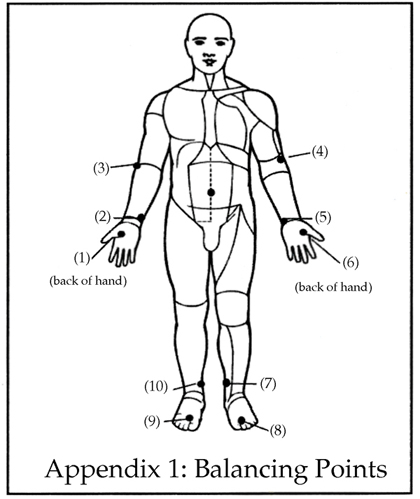
Joachim P. Seckel, M.A., Acupr., NAET is a researcher based in Albany, California.
Share with us (Comments,contributions,opinions)
When reproducing this feature, please credit NAMAH,and give the byline. Please send us cuttings.


